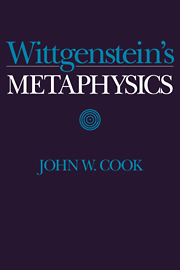Book contents
- Frontmatter
- Contents
- Preface
- List of Abbreviations
- Introduction
- Part I From Idealism to Pure Realism
- Part II The Metaphysics of Wittgenstein's Later Philosophy
- 7 Wittgenstein's Phenomenalism
- 8 A New Philosophical Method
- 9 Wittgenstein's Behaviorism
- 10 Wittgenstein and Kohler
- Part III Causation and Science in a Phenomenal World
- Part IV Logical Possibilities and the Possibility of Knowledge
- Part V The Past, Memory, and The Private Language Argument
- Name Index
- Subject Index
8 - A New Philosophical Method
Published online by Cambridge University Press: 05 November 2011
- Frontmatter
- Contents
- Preface
- List of Abbreviations
- Introduction
- Part I From Idealism to Pure Realism
- Part II The Metaphysics of Wittgenstein's Later Philosophy
- 7 Wittgenstein's Phenomenalism
- 8 A New Philosophical Method
- 9 Wittgenstein's Behaviorism
- 10 Wittgenstein and Kohler
- Part III Causation and Science in a Phenomenal World
- Part IV Logical Possibilities and the Possibility of Knowledge
- Part V The Past, Memory, and The Private Language Argument
- Name Index
- Subject Index
Summary
As we saw in the preceding chapter Wittgenstein did not, in his later years, abandon phenomenalism. What he abandoned was only the Tractatus view that the propositions of ordinary language are truth-functionally constructed from more elementary propositions. But this change required a modification of Wittgenstein's ideas about philosophical method. While he continued to think that philosophical problems arise from misunderstandings of the ‘logic’ of our language, he could no longer think that such misunderstandings can be corrected by logical analysis. The idea of analysis is the idea that a philosopher can dissect our ordinary propositions into those sense-datum propositions from which they are truth-functionally constructed and can thereby show, for example, that Moore was wrong to oppose Berkeley's account of propositions about material objects. But with analysis now out of the question, the discovery of a new method became an urgent matter for Wittgenstein.
The discovery was not long in coming. Drury reports that Wittgenstein said to him in 1930: “I know that my method is right.” And Moore, in his account of Wittgenstein's lectures of 1930–1933, reports him as saying that his particular results did not matter as much as the fact that “a method had been found.” What was this new method?
- Type
- Chapter
- Information
- Wittgenstein's Metaphysics , pp. 101 - 118Publisher: Cambridge University PressPrint publication year: 1994



